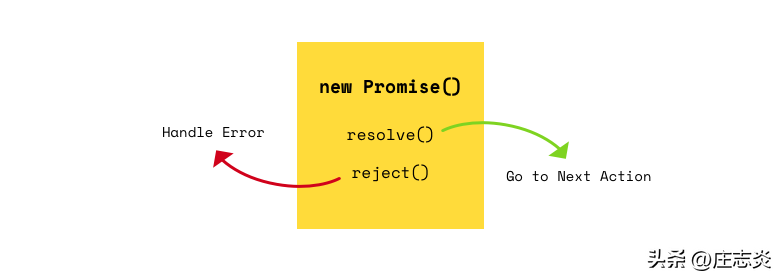Promise 模式是现代 JavaScript 编程的必备条件。 使用 then/catch 链接看起来很简单,但它有一些我们最好知道的细节。 这篇文章将带来关于 Promise 的 5 件事。

1. 反复解决
如果下面的代码运行会发生什么?
new Promise(resolve => {
resolve(new Promise(resolve => {
resolve(new Promise(resolve => {
resolve(10)
}))
}))
})
.then(value => console.log(value)) // 10- 1.
- 2.
- 3.
- 4.
- 5.
- 6.
- 7.
- 8.
then() 给你 10(不是 Promise 实例)。 如果解析的值是一个 Promise,那么它会解析直到它不能 then-able。
2.返回链
then() 链不仅是函数链,还是价值链。
Promise.resolve(10)
.then(value => value + 1)
.then(value => value + 1)
.then(value => console.log(value)) // 12- 1.
- 2.
- 3.
- 4.
第一个 then() 为该值提供 10,第二个为 11,第三个为 12。它还对返回的值应用循环链,因此以下代码的工作方式相同。
Promise.resolve(10)
.then(value => value + 1)
.then(value => Promise.resolve(value + 1))
.then(value => console.log(value)) // 12- 1.
- 2.
- 3.
- 4.
3.then()的第二个参数
then() 实际上有 2 个参数。 第二个参数采用一个函数来处理拒绝的情况。 它与 catch() 的工作方式非常相似。 以下代码的结果是相同的。
/// then() with second parameter
Promise.reject(10)
.then(
value => value + 1,
reason => handleError(reason), // reason=10
)/// then() and catch()
Promise.reject(10)
.then(value => value + 1)
.catch(reason => handleError(reason)) // reason=10- 1.
- 2.
- 3.
- 4.
- 5.
- 6.
- 7.
- 8.
- 9.
如果我们两个都像下面这样呢?
Promise.reject(10)
.then(
value => value + 1,
reason => handleError1(reason), // called
)
.catch(reason => handleError2(reason)) // not called- 1.
- 2.
- 3.
- 4.
- 5.
- 6.
如果两者都给出,则 then() 的第二个参数在 catch() 之前,因此调用了 handleError1() 而不会调用 handleError2()。 唯一的例外是 Promise 实际抛出错误的情况。 请参阅下面的代码。
new Promise(() => { throw 'error' })
.then(
value => value + 1,
reason => handleError1(reason), // not called
)
.catch(reason => handleError2(reason)) // called- 1.
- 2.
- 3.
- 4.
- 5.
- 6.
它仅在 catch() 子句中捕获错误,因此调用了 handleError2()。 一个有趣的部分是,如果它没有 catch(),即使使用 onReject 参数也会抛出错误。
4. then() 中抛出错误
如果 then() 中发生错误,它会在 catch() 子句中捕获。
Promise.resolve(10)
.then(value => { throw 'error' })
.catch(reason => handleError(reason)) // catch!- 1.
- 2.
- 3.
5.错误作为一个值
如果我们尝试用错误来解决,这听起来很有趣。 你能想象下面的代码会发生什么吗?
Promise.resolve(new Error('error'))
.then(value => console.log(value)) // Error value
.catch(reason => handleError(reason))- 1.
- 2.
- 3.
它不会捕获但会正常解析,因此它会记录原始错误。 Promise 不赋予 Error 权限,而是 Promise 本身。
..和一个建议
Promise 模式对于处理异步作业很有用,但它通常涉及带有嵌套 Promise 的曲线代码。 它不利于阅读,因此另一种选择是使用 async/await。 现代 JavaScript 打包器提供了 async/await 语法的转换。

































